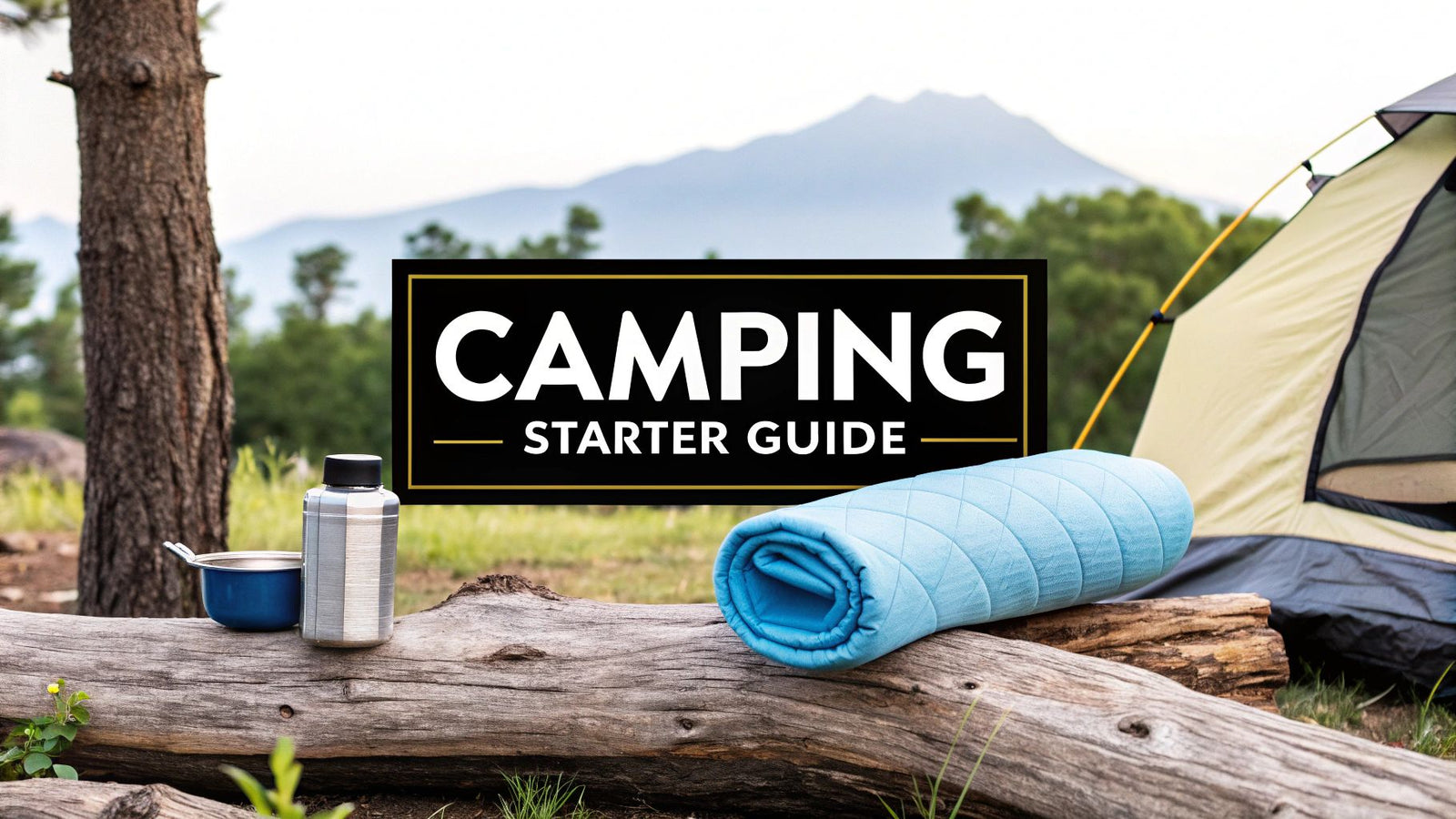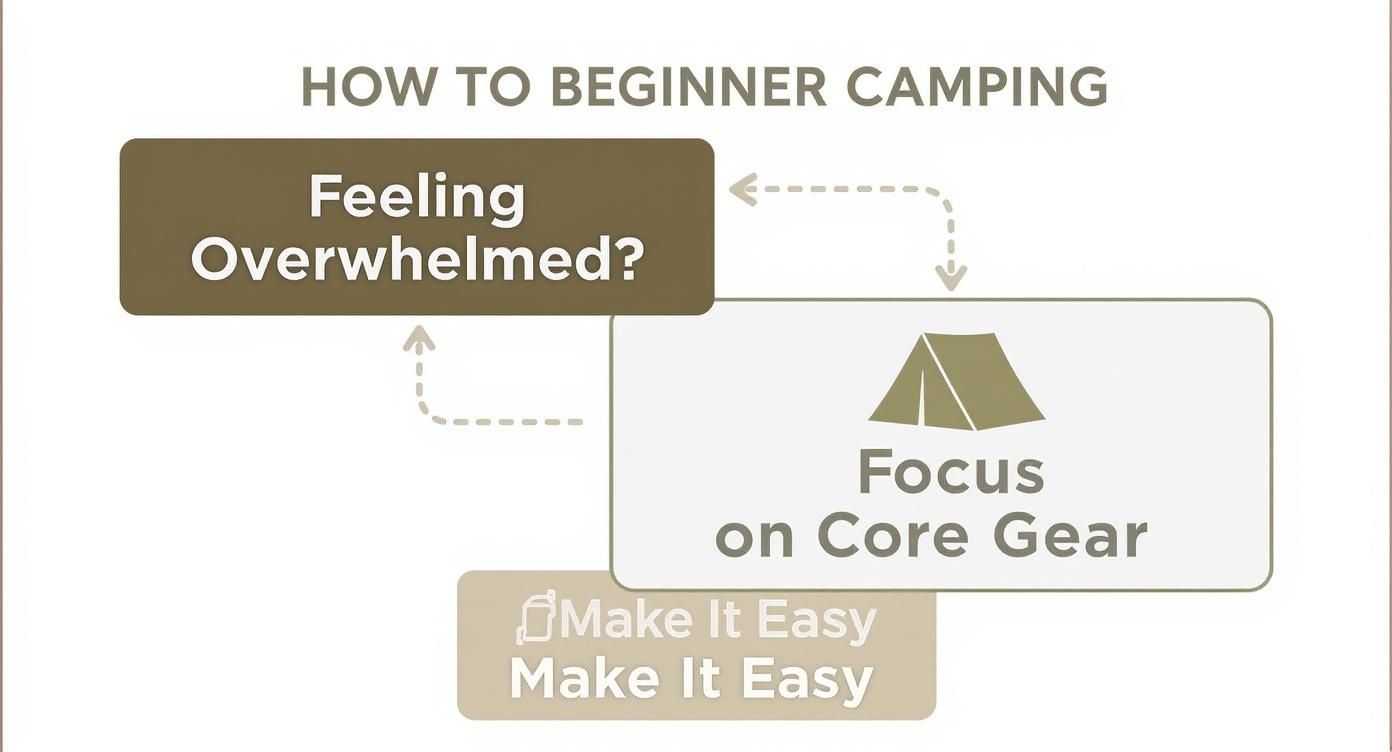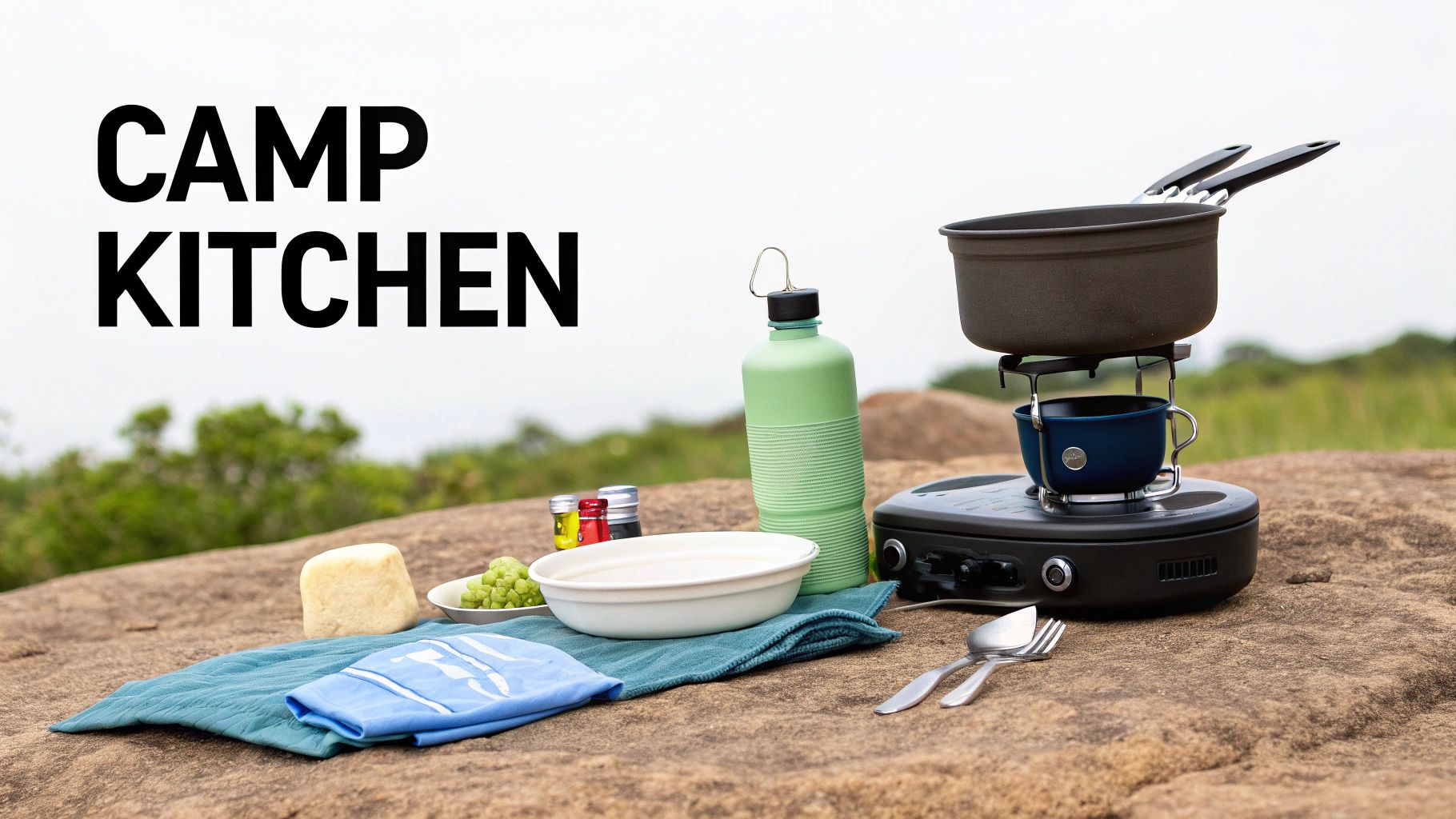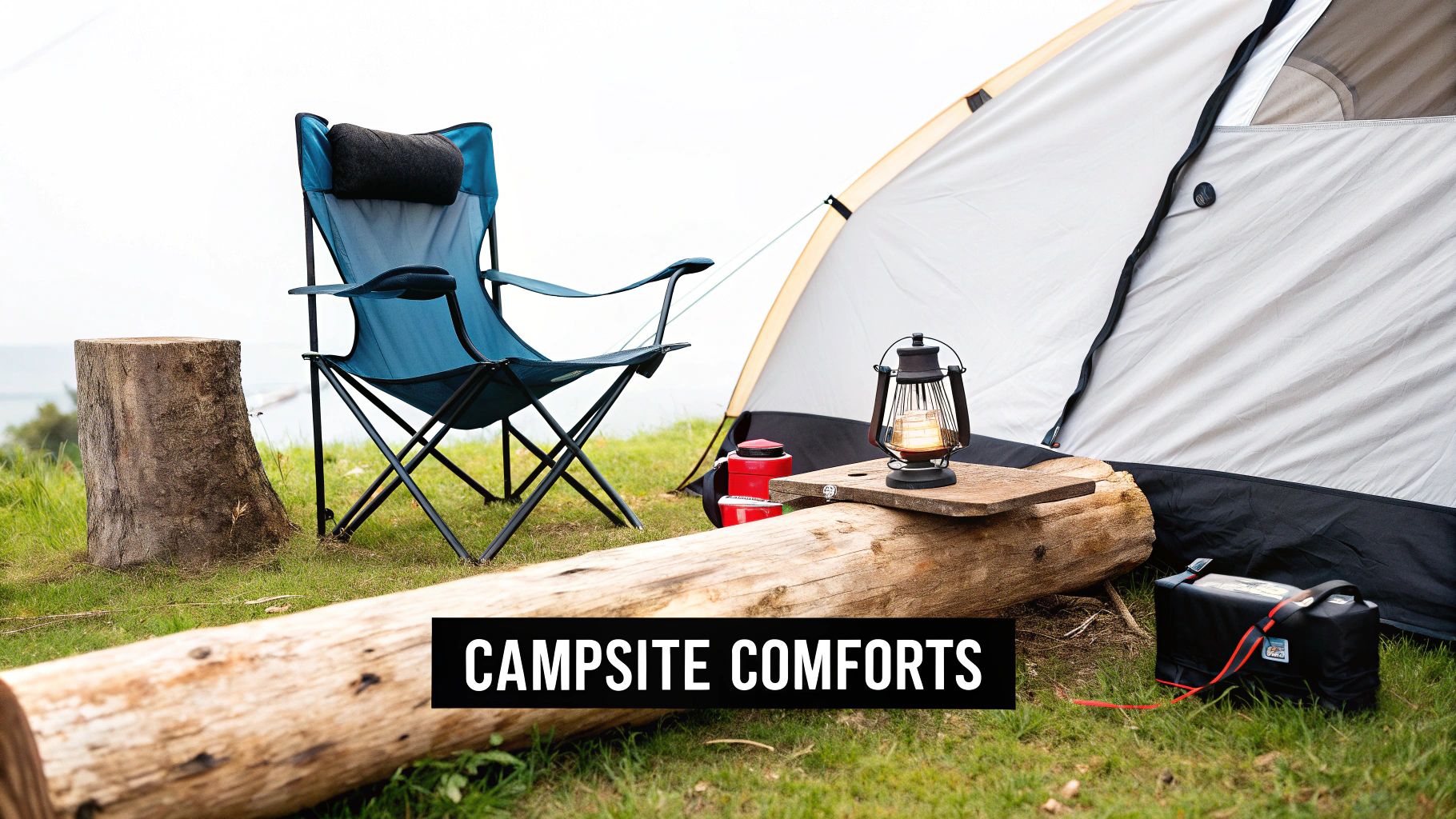Best Camping Gear for Beginners Ultimate Starter Guide

Diving into the world of camping can feel a bit like staring at a massive, confusing map with no "you are here" marker. Gear lists seem endless, and every "expert" has a different opinion. Let's cut through the noise.
This guide isn't about buying every gadget in the outdoor store. It’s about focusing on the right gear—the stuff that will make your first trip comfortable, safe, and genuinely fun. We're building a solid starter kit you can trust, one you can add to as you get more trips under your belt.
Smart, Practical Gear is the Name of the Game
The good news? Camping equipment today is better and more beginner-friendly than ever. You can find gear that's light, tough, and won't completely drain your bank account. The key is to look for smart, space-saving designs that make packing and setting up a breeze.
Making your first trip to an accessible and beautiful spot, like some of the popular hiking trails, can turn any first-time jitters into pure excitement. Having the right gear is what makes it all possible.
Take HYDAWAY’s gear, for instance. It’s a perfect example of solving a classic camping problem. Instead of wrestling with bulky, rigid water bottles that hog pack space, their collapsible bottles flatten to just over an inch thick when they're empty. For a beginner, this means one less thing to worry about when packing the car; your water bottle can be tucked into a side pocket or glove compartment until you reach the trailhead.
The same idea applies to their collapsible travel bowls. They make mealtime and cleanup incredibly simple. This is exactly the kind of smart, practical gear that's perfect for beginners because it’s useful way beyond the campsite—think road trips, picnics, or even packing your lunch for work.
Remember, the best beginner gear is gear that removes barriers. It should make you feel capable and excited to get outside, not stressed about what to pack or how much to spend.
It’s no secret that more people are heading outdoors. The global camping equipment market hit around $17.82 billion in 2025 and is only expected to keep climbing. This boom is driven by people wanting the health benefits of nature and by huge leaps in gear technology, making it easier than ever to start. For newcomers, this trend means more options and better products to choose from. Discover more insights about the camping equipment market.
The Core Three: Shelter and Your Sleep System
Let’s be honest, a great night's sleep is the secret ingredient to any successful camping trip. It’s what resets your energy. It’s the difference between waking up sore and groggy versus refreshed and ready for whatever the day holds. This is where your "Core Three"—the tent, sleeping bag, and sleeping pad—come in. Together, they form the foundation of your portable home away from home.
Finding Your Tent
Your tent is more than just a roof over your head; it’s your safe haven from wind, rain, and those buzzing bugs. When you start shopping, you'll immediately see terms like "3-season" and "capacity." A 3-season tent is the perfect starting point for most people, as it’s designed for the milder conditions of spring, summer, and fall.
Capacity simply means how many people can sleep inside—but take that number with a grain of salt. It's often a very tight squeeze.
For a family of four heading out for a weekend of car camping, a spacious 4-person or even a 6-person tent offers plenty of room for everyone and their gear without feeling like sardines. On the other hand, if you and a partner are testing the waters of backpacking, a lightweight 2-person tent is a much more practical choice for carrying on the trail.
To help you sort through the options, here’s a quick guide to the most common tent types you'll encounter.
Beginner Tent Selection Guide
| Tent Type | Best For | Pros | Cons |
|---|---|---|---|
| Dome Tent | Car camping, festivals, beginners | Affordable, easy to set up, good wind resistance | Less headroom, can feel cramped with max capacity |
| Cabin Tent | Family car camping, group trips | Near-vertical walls, tons of headroom, spacious | Bulky and heavy, not ideal for high winds |
| Backpacking Tent | Hiking, multi-day trips, solo campers | Extremely lightweight, compact, weather-resistant | Expensive, limited interior space, snug fit |
| Instant/Pop-Up Tent | Casual campers, first-timers | Incredibly fast and easy setup | Can be bulky when packed, less durable, poor weather performance |
Choosing the right style comes down to how you plan to camp. For most beginners sticking to established campgrounds, a simple dome tent is a fantastic, no-fuss starting point.
Choosing Your Sleeping Bag And Pad
Next up is your sleeping bag, which is all about one thing: staying warm. The most important feature to look at is its temperature rating. This number tells you the lowest temperature at which an "average sleeper" will feel comfortable. For most summer camping in the U.S., a bag rated between 30°F to 40°F (-1°C to 4°C) is a versatile and safe bet.
You’ll also have two main insulation choices:
- Down: Prized for being incredibly lightweight and easy to pack down small, it’s a favorite for backpackers. The big catch? It loses its insulating power when it gets wet.
- Synthetic: While it's bulkier and heavier than down, synthetic insulation keeps you warm even when damp. It's also typically more affordable, making it a reliable, worry--free choice for new campers.
Finally, we have the sleeping pad—the unsung hero of campsite comfort. It does two critical jobs: cushioning you from the hard, lumpy ground and, more importantly, insulating you from the cold that radiates up from it. A good pad prevents you from waking up with a chill, even if your sleeping bag is toasty.
Newcomers are finding fantastic value in today's camping and hiking gear market. In the U.S. alone, this market was valued at around $8.61 billion in 2024, driven by a collective desire to disconnect and enjoy the outdoors. This boom means more user-friendly and affordable options are available than ever before.
This simple decision tree can help you focus on what's most important as you get started.

The key takeaway? Avoid getting overwhelmed. Start with your shelter system, then add items that make life easier. For instance, once you know your tent and sleeping bag fit in your car, you can see how much space is left for kitchen gear and easily recognize the value of space-saving items like collapsible bowls and bottles.
Your sleep system is a team effort. A 20°F bag won't keep you warm at 20°F without a properly insulated pad underneath you. They work together to guarantee a comfortable night.
As you dial in your sleep system, think about how weight and packed size fit your camping style. If you dream of multi-day hikes, every ounce matters. For tips on shedding weight without sacrificing the essentials, check out our ultralight camping gear list. Getting your shelter and sleep system right is your ticket to safety, comfort, and amazing adventures in the great outdoors.
Your Camp Kitchen Cooking and Hydration Basics
Let's be honest, good food and plenty of water are the secret ingredients to a happy camper. Don't worry about complicated campfire recipes for your first trip out. Building a simple, functional camp kitchen is really just about having the right tools to make easy meals and stay hydrated.
Think of this setup as the heart of your campsite—it’s what provides the fuel you need for all that adventure.

Choosing Your First Camp Stove
Cooking over an open fire feels iconic, but it’s not always practical—or even permitted, thanks to frequent fire bans. A reliable camp stove is an absolute must-have and truly one of the best camping gear for beginners. It just gives you control, speed, and convenience that you can't get from an open flame.
If you're car camping, you can't beat a classic two-burner propane stove. Models like the Coleman Classic are legendary for a reason: they're affordable, practically indestructible, and let you cook with a pot and a pan at the same time. Morning bacon and eggs? No problem. They hook up to those little green propane canisters you can find almost anywhere.
On the other hand, if you think backpacking might be in your future, investing in a smaller canister stove like the MSR PocketRocket Deluxe is a brilliant move. These little guys are tiny, screw right onto a fuel canister, boil water in minutes, and weigh next to nothing.
Assembling Your Kitchen Kit
Once you’ve got a stove, you just need a few other key items to actually prep and eat your meals. You don't need to pack up your entire kitchen drawer, just the essentials to get you started.
Here’s a simple checklist to build out your beginner camp kitchen:
- A Small Pot: Something in the 1-2 liter range is perfect for boiling water for coffee, rehydrating freeze-dried meals, or making a bit of pasta.
- Utensils: A long-handled spork is a backpacker's best friend, but any sturdy fork and spoon will work. Don’t forget a spatula or a big spoon for cooking!
- A Mug and Bowl: Look for something durable and lightweight. An insulated mug is a game-changer for keeping that morning coffee hot just a little longer.
- Biodegradable Soap and Sponge: Grab a camp-specific soap. It's designed to minimize your impact on the environment.
- Trash Bags: Always, always pack out what you pack in. It's a good rule of thumb to bring more bags than you think you'll need.
So many first-timers make the mistake of packing fragile ceramic plates or heavy metal cookware from home. That stuff is bulky, heavy, and can easily break on the way. Purpose-built camp dinnerware is designed to be lightweight, tough, and incredibly space-efficient.
Smart Hydration and Dinnerware Solutions
Staying hydrated is non-negotiable, but let's face it—lugging around bulky, empty water bottles is a real pain. This is exactly where smart, collapsible design makes a huge difference.
The HYDAWAY 17oz Collapsible Water Bottle is the perfect sidekick for day hikes away from your main campsite. When you're done drinking, it squashes down to almost nothing and fits right in your pocket. No more empty bottles taking up space or clanking around in your pack. That means after you finish your water at a scenic overlook, you can collapse the bottle and tuck it away, making the hike back to camp more comfortable and quiet.
The same idea makes meal cleanup and packing a breeze. Imagine finishing your chili, giving your bowl a quick rinse, and then squashing your HYDAWAY Collapsible Camp Bowl down to the size of a cookie. It's ridiculously satisfying and saves a shocking amount of room in your pack or camp box.
For more clever ideas on outfitting your kitchen, check out our complete guide to collapsible camping cookware. These kinds of products solve those classic camping problems of bulk and inconvenience, letting you focus more on enjoying your meal and less on the cleanup afterward.
Dressing for the Outdoors: Clothing and Personal Gear
Of all the gear you'll bring camping, what you wear is arguably the most critical. The right clothes can be the difference between an incredible trip you'll remember for years and a downright miserable experience.
The secret to comfort in the wild isn't packing a massive wardrobe. It's all about layering.
This isn't some complex technical skill reserved for seasoned mountaineers. Layering simply means wearing several lighter garments instead of one big, bulky jacket. This approach is brilliant because it lets you adapt on the fly. Cool mountain mornings often turn into warm, sunny afternoons, and layering lets you peel back or add clothes to stay perfectly comfortable all day long.
The Three Key Layers
Think of your clothing as a three-part system, with each piece doing a specific job.
-
Base Layer: This is what's right against your skin. Its only job is to pull sweat away from your body to keep you dry. Look for merino wool or synthetics like polyester. Whatever you do, avoid cotton—it's a classic rookie mistake. Cotton soaks up moisture and holds it against you, which can make you dangerously cold.
-
Mid-Layer: This is your insulation. Its job is to trap your body heat and keep you warm when temperatures drop. Fleece jackets, puffy vests, or down jackets are perfect mid-layers. A cozy fleece pullover is a fantastic, effective, and affordable choice for any beginner.
-
Outer Layer (Shell): This is your shield from the elements. A waterproof and windproof jacket is your best friend in a sudden downpour or when the wind picks up. Even if the forecast is crystal clear, packing a rain shell is a non-negotiable safety item.
For a beginner camper, a typical day might look like this: you start with a merino wool t-shirt, add a fleece jacket when the sun goes down for campfire stories, and have a rain shell packed and ready just in case. This simple setup has you covered for almost anything.
Beyond your main clothing layers, a few other personal items are absolute must-haves for a safe and comfortable trip.
Sturdy hiking shoes with good ankle support are a much smarter choice than regular sneakers. They provide the traction and stability you need for walking on uneven trails. Don't forget sun protection like a wide-brimmed hat and sunscreen, and always pack a reliable insect repellent.
You'll also need a well-stocked first-aid kit and some form of navigation. This doesn't mean you need a fancy GPS device right away; a downloaded map on your phone (from an app like AllTrails) works perfectly when you're starting out.
Being strategic about these smaller items is key. You can find some great advice on how to pack light to make sure you have everything you need without feeling like you're carrying a ton of bricks on your back.
Essential Beginner Camper's First-Aid Kit
You don't need to bring the entire medicine cabinet, but a well-thought-out first-aid kit is crucial. You can buy pre-made kits, but building your own ensures you have exactly what you need for minor scrapes, bug bites, and blisters.
Here’s a checklist to get you started:
| Category | Item | Recommended Quantity |
|---|---|---|
| Wound Care | Adhesive Bandages (various sizes) | 10-15 assorted |
| Antiseptic Wipes | 10-12 wipes | |
| Antibiotic Ointment | 1 small tube | |
| Gauze Pads (sterile) | 4-6 pads | |
| Medical Tape | 1 roll | |
| Blister Care | Moleskin or Blister Pads | 1 small package |
| Medication | Pain Relievers (Ibuprofen/Acetaminophen) | 10-12 tablets |
| Antihistamines (for allergic reactions) | 6-8 tablets | |
| Tools | Small Scissors | 1 pair |
| Tweezers | 1 pair |
Remember to check your kit before every trip to restock any used items and ensure medications haven't expired. A little preparation goes a long way toward peace of mind on the trail.
Campsite Comforts Tools and Essential Extras
Alright, you've got your shelter, kitchen, and clothing figured out. Now for the fun part: turning that patch of dirt into a place you actually want to hang out. This is all about the gear that handles the little things, boosts your comfort level, and makes the whole experience so much better you’ll be planning your next trip before the first one is even over.

Let's start with a few things that are pretty much non-negotiable. First, a solid headlamp. Trust me, it’s way better than a flashlight. It keeps your hands free for cooking dinner, digging through your tent for a warm jacket, or making that late-night trip to the bathroom.
Next up, a versatile multi-tool. You’d be surprised how often this little gadget saves the day, whether you're making a quick gear repair, opening a stubborn food package, or cutting a piece of rope.
And please, don't underestimate the power of a comfortable camp chair. After a long day of hiking, there's nothing better than sinking into a proper chair by the fire. It’s a simple luxury that makes a huge difference.
Modern Conveniences For New Campers
Beyond the absolute basics, a few modern tools can make camping feel a lot more accessible and secure, especially if you're just starting out. These aren't just cushy extras; they solve real problems and ease common anxieties about being outdoors.
This is where you can really see how technology has changed what we consider the best camping gear for beginners. The global market for this stuff was valued at nearly $90 billion in 2024 and is expected to jump to over $172 billion by 2032. That boom is all thanks to smart gear like solar-powered chargers and GPS tools that make the outdoors feel safer and less intimidating. You can learn more about these camping market trends if you're curious.
Here are a few modern essentials worth looking into:
- Portable Power Bank: This is a big one. Your phone isn't just for Instagram stories; it’s your map, your camera, and your emergency line to the outside world. A simple 10,000mAh power bank can give most smartphones two or three full charges.
- Solar-Powered Lantern: Ditch the single, harsh beam of your headlamp for campsite lighting. A solar lantern casts a warm, ambient glow that’s perfect for playing cards or just hanging out. Many, like the popular LuminAID PackLite, soak up sun all day to keep you lit all night.
- A Packable Daypack: You have your main pack for all your gear, but a smaller, lightweight backpack is perfect for short hikes away from camp. The HYDAWAY Collapsible Daypack is a brilliant example—it packs down into its own tiny pocket, taking up almost no space until you need it for water, snacks, and a rain jacket. A practical use case is keeping it stashed in your car; when you spontaneously decide to hike to a waterfall near your campsite, you can quickly unfold it and be on your way.
Investing in these comfort items isn't about "glamping." It's about removing the small frictions that can make a first trip feel challenging. When you're comfortable and your basic needs are met, you can truly relax and enjoy the experience.
These tools are the perfect bridge between roughing it and feeling right at home in nature. They keep your devices charged, your site well-lit, and your options open for spontaneous adventures—exactly what a new camper needs to build confidence and fall in love with the outdoors.
Answering Your Top Beginner Camping Questions
Even with a killer gear list, a few questions always seem to pop up before that first big trip. Feeling a little uncertain is totally normal. Let's walk through some of the most common worries new campers have, so you can head out feeling confident and ready.
Should I Rent or Buy Gear for My First Time?
This is a classic first-timer dilemma! Renting is a fantastic, low-commitment way to dip your toes in the water. It lets you try out camping without dropping a bunch of cash right away.
I always suggest renting the "Big Three"—your tent, sleeping bag, and sleeping pad—from a local outdoor shop. This gives you a real feel for what you like and don't like in the field. Maybe you'll find you need a warmer sleeping bag than you thought, or that a side-entry tent is a must-have. You learn these things by doing, not by reading reviews.
If you’re hooked after one or two trips (and you probably will be), then it makes sense to start buying your own gear. A great way to start is with versatile pieces you can use for other activities. Think about a durable HYDAWAY water bottle that you can take to the gym or a collapsible camp bowl for picnics and work lunches. Build your kit piece by piece, starting with things that serve you both on and off the trail.
What Are the Biggest Packing Mistakes Beginners Make?
Oh, the packing mistakes. We’ve all been there. The two biggest rookie errors are polar opposites: overpacking useless stuff and under-packing the critical stuff.
It’s so tempting to bring that cozy cotton hoodie or your favorite ceramic mug from home. But bulky, fragile items just create a logistical nightmare at the campsite. On the flip side, forgetting a rain jacket, an extra warm layer, or a headlamp can quickly turn a fun trip into an uncomfortable—or even unsafe—one.
The secret weapon here is simple: use a checklist. Seriously. Lay everything out before it goes into your pack and ask yourself, "Does this serve a core purpose for my shelter, warmth, food, or safety?" This one question is amazing for filtering out the "what ifs" from the "must-haves."
Always lean toward multi-functional and packable gear. It just makes life easier and your pack lighter. Products like HYDAWAY's are designed for this exact purpose, helping you avoid the classic beginner mistake of hauling bulky, single-use items.
How Much Should a Basic Camping Kit Cost?
Let's talk numbers. A complete, brand-new beginner camping setup can run you anywhere from $300 to $700 per person.
The biggest chunk of that will go to your shelter and sleep system. For a reliable, entry-level tent, sleeping bag, and sleeping pad, you can expect to spend somewhere between $150 and $400. These are your comfort items, so it's a good place to invest.
A simple camp stove and basic cookware might add another $50 to $100. The rest of your budget will cover those smaller but equally important essentials like a headlamp, a comfy camp chair, and a first-aid kit.
To keep costs down, shop end-of-season sales, check out quality used gear from trusted sources, and really think about where your money will have the biggest impact on your comfort and safety.
Ready to build a smarter, more packable kit? Start with gear that saves space and solves problems. Explore the full collection of collapsible, adventure-ready gear from HYDAWAY and see how easy packing can be. Check out the gear at https://myhydaway.com.



